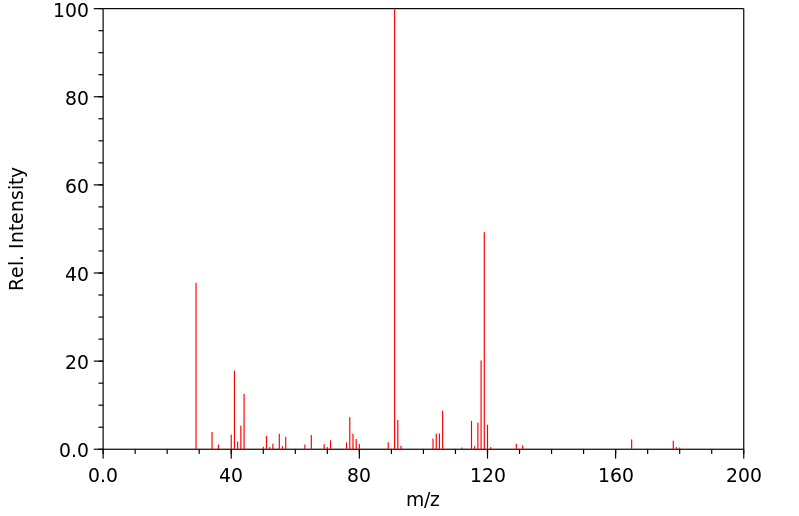3,4-diphenyl-hexane | 68398-19-6
中文名称
——
中文别名
——
英文名称
3,4-diphenyl-hexane
英文别名
Hexane, 3,4-diphenyl-;4-phenylhexan-3-ylbenzene
CAS
68398-19-6
化学式
C18H22
mdl
——
分子量
238.373
InChiKey
JTJWVUQPSOFEPZ-UHFFFAOYSA-N
BEILSTEIN
——
EINECS
——
-
物化性质
-
计算性质
-
ADMET
-
安全信息
-
SDS
-
制备方法与用途
-
上下游信息
-
文献信息
-
表征谱图
-
同类化合物
-
相关功能分类
-
相关结构分类
计算性质
-
辛醇/水分配系数(LogP):5.9
-
重原子数:18
-
可旋转键数:5
-
环数:2.0
-
sp3杂化的碳原子比例:0.33
-
拓扑面积:0
-
氢给体数:0
-
氢受体数:0
上下游信息
-
上游原料
中文名称 英文名称 CAS号 化学式 分子量 2-苯基丁酰苯 1,2-diphenyl-butan-1-one 16282-16-9 C16H16O 224.302
反应信息
-
作为反应物:参考文献:名称:Torf,S.F.; Khromov-Borisov,N.V., Journal of general chemistry of the USSR, 1961, vol. 31, p. 1965 - 1968摘要:DOI:
-
作为产物:描述:参考文献:名称:还原性氧化石墨烯负载的PtPd @ Pt多孔纳米球催化的非偶合基团sp3 C–H活化,通过均相偶合合成联苄。摘要:很少探索使用非均相双金属钯基纳米催化剂指导失活的sp 3 C-H偶联。这项工作报道了通过使用还原性氧化石墨烯负载的PtPd @ Pt多孔纳米球催化的灭活的sp 3 C-H键形成对称的C-C键。sp 3 C H活化反应在温和条件下进行,没有任何溶剂,配体或指导基团。在合成具有各种官能团(例如芳基,烷基,甲氧基,卤素,酯和吡啶基)的联苄中,开发多相催化剂是一种更高的原子,步骤和成本效益策略。DOI:10.1002/adsc.201701389
文献信息
-
Organotitanium chemistry XVIII. Dehalogenation of organic halides by Cp2TiX (X = Cl, Br)作者:Qian Yanlong、Li Guisheng、Yao-Zeng HuangDOI:10.1016/0022-328x(90)85446-6日期:1990.1Dicyclopentadienyltitanium chloride and bromide prepared in situ from the reduction of dicyclopentadienyltitanium dichloride by isopropylmagnesium chloride and bromide, respectively, are effective dehalogenating reagents for benzylic, allylic halides and α-bromoketones. Benzylic and allylic halides are transformed into the coupling products whereas the α-bromoketones are reduced to the corresponding ketones
-
Facile reductive coupling of benzylic halides with ferrous oxalate dihydrate作者:Jitender M. Khurana、Sushma Chauhan、Golak C. MaikapDOI:10.1039/b211792d日期:2003.5.15Facile reductive coupling of benzylic halides is reported with ferrous oxalate dihydrate in DMF or HMPA under nitrogen atmosphere at 155–160 °C. The coupling is proposed to proceed by two successive oxidative additions of benzylic halides to ferrous oxalate to give an intermediate organoiron complex which undergoes concerted dimerization to give the corresponding reductively coupled dimers in high yields.
-
Correction to “Nickel-Catalyzed Asymmetric Reductive Cross-Coupling To Access 1,1-Diarylalkanes”作者:Kelsey E. Poremba、Nathaniel T. Kadunce、Naoyuki Suzuki、Alan H. Cherney、Sarah E. ReismanDOI:10.1021/jacs.8b05247日期:2018.6.20Pages 5684 and 5685, Table of第 5684 页和第 5685 页,表
-
Copper(II)-Photocatalyzed N–H Alkylation with Alkanes作者:Yi-Wen Zheng、Rok Narobe、Karsten Donabauer、Shahboz Yakubov、Burkhard KönigDOI:10.1021/acscatal.0c01924日期:2020.8.7of N–H bonds with alkanes using a photoinduced copper(II) peroxide catalytic system. Upon light irradiation, the peroxide serves as a hydrogen atom transfer reagent to activate stable C(sp3)–H bonds for the reaction with a broad range of nitrogen nucleophiles. The method enables the chemoselective alkylation of amides and is utilized for the late-stage functionalization of N–H bond containing pharmaceuticals
-
Ruthenium‐Catalyzed Dehydrogenation Through an Intermolecular Hydrogen Atom Transfer Mechanism作者:Lin Huang、Alessandro Bismuto、Simon A. Rath、Nils Trapp、Bill MorandiDOI:10.1002/anie.202015837日期:2021.3.22The direct dehydrogenation of alkanes is among the most efficient ways to access valuable alkene products. Although several catalysts have been designed to promote this transformation, they have unfortunately found limited applications in fine chemical synthesis. Here, we report a conceptually novel strategy for the catalytic, intermolecular dehydrogenation of alkanes using a ruthenium catalyst. The combination
表征谱图
-
氢谱1HNMR
-
质谱MS
-
碳谱13CNMR
-
红外IR
-
拉曼Raman
-
峰位数据
-
峰位匹配
-
表征信息
同类化合物
(E,Z)-他莫昔芬N-β-D-葡糖醛酸
(E/Z)-他莫昔芬-d5
(4S,5R)-4,5-二苯基-1,2,3-恶噻唑烷-2,2-二氧化物-3-羧酸叔丁酯
(4S,4''S,5R,5''R)-2,2''-(1-甲基亚乙基)双[4,5-二氢-4,5-二苯基恶唑]
(4R,5S)-4,5-二苯基-1,2,3-恶噻唑烷-2,2-二氧化物-3-羧酸叔丁酯
(4R,4''R,5S,5''S)-2,2''-(1-甲基亚乙基)双[4,5-二氢-4,5-二苯基恶唑]
(1R,2R)-2-(二苯基膦基)-1,2-二苯基乙胺
鼓槌石斛素
黄子囊素
高黄绿酸
顺式白藜芦醇三甲醚
顺式白藜芦醇
顺式己烯雌酚
顺式-白藜芦醇3-O-beta-D-葡糖苷酸
顺式-桑皮苷A
顺式-曲札芪苷
顺式-二苯乙烯
顺式-beta-羟基他莫昔芬
顺式-a-羟基他莫昔芬
顺式-3,4',5-三甲氧基-3'-羟基二苯乙烯
顺式-1-(3-甲基-2-萘基)-2-(2-萘基)乙烯
顺式-1,2-双(三甲基硅氧基)-1,2-双(4-溴苯基)环丙烷
顺式-1,2-二苯基环丁烷
顺-均二苯乙烯硼酸二乙醇胺酯
顺-4-硝基二苯乙烯
顺-1-异丙基-2,3-二苯基氮丙啶
非洲李(PRUNUSAFRICANA)树皮提取物
阿非昔芬
阿里可拉唑
阿那曲唑二聚体
阿托伐他汀环氧四氢呋喃
阿托伐他汀环氧乙烷杂质
阿托伐他汀环(氟苯基)钠盐杂质
阿托伐他汀环(氟苯基)烯丙基酯
阿托伐他汀杂质D
阿托伐他汀杂质94
阿托伐他汀杂质7
阿托伐他汀杂质5
阿托伐他汀内酰胺钠盐杂质
阿托伐他汀中间体M4
阿奈库碘铵
锌(II)(苯甲醛)(四苯基卟啉)
银松素
铜酸盐(5-),[m-[2-[2-[1-[4-[2-[4-[[4-[[4-[2-[4-[4-[2-[2-(羧基-kO)苯基]二氮烯基-kN1]-4,5-二氢-3-甲基-5-(羰基-kO)-1H-吡唑-1-基]-2-硫代苯基]乙烯基]-3-硫代苯基]氨基]-6-(苯基氨基)-1,3,5-三嗪-2-基]氨基]-2-硫代苯基]乙烯基]-3-硫代
铒(III) 离子载体 I
铀,二(二苯基甲酮)四碘-
钾钠2,2'-[(E)-1,2-乙烯二基]二[5-({4-苯胺基-6-[(2-羟基乙基)氨基]-1,3,5-三嗪-2-基}氨基)苯磺酸酯](1:1:1)
钠{4-[氧代(苯基)乙酰基]苯基}甲烷磺酸酯
钠;[2-甲氧基-5-[2-(3,4,5-三甲氧基苯基)乙基]苯基]硫酸盐
钠4-氨基二苯乙烯-2-磺酸酯







